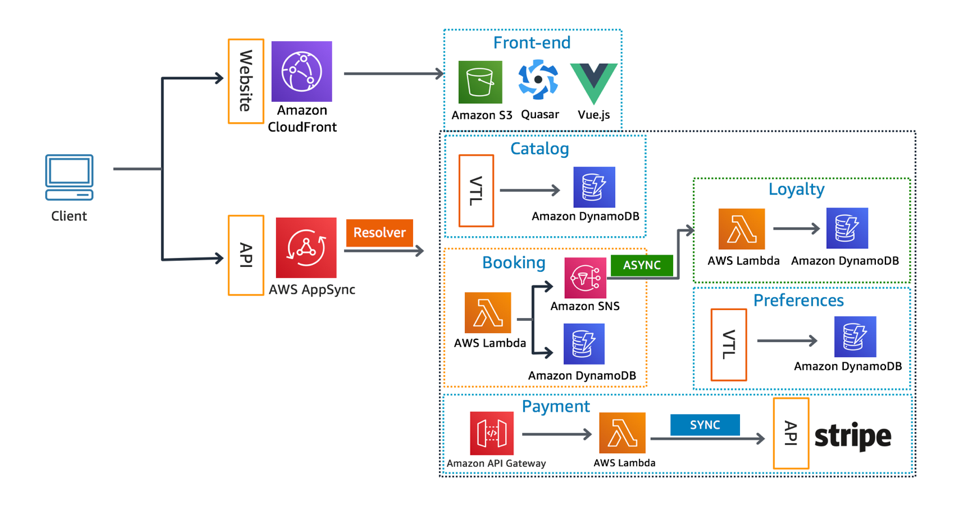AWS Compute Blog
Tag: Step Functions
Introducing larger state payloads for AWS Step Functions
AWS Step Functions allows you to create serverless workflows that orchestrate your business processes. Step Functions stores data from workflow invocations as application state. Today we are increasing the size limit of application state from 32,768 characters to 256 kilobytes of data per workflow invocation. The new limit matches payload limits for other commonly used […]
AWS Step Functions support in Visual Studio Code
The AWS Toolkit for Visual Studio Code has been installed over 115,000 times since launching in July 2019. We are excited to announce toolkit support for AWS Step Functions, enabling you to define, visualize, and create your Step Functions workflows without leaving VS Code. Version 1.8 of the toolkit provides two new commands in the […]
Orchestrating a security incident response with AWS Step Functions
In this post I will show how to implement the callback pattern of an AWS Step Functions Standard Workflow. This is used to add a manual approval step into an automated security incident response framework. The framework could be extended to remediate automatically, according to the individual policy actions defined. For example, applying alternative actions, or […]
Configuring user creation workflows with AWS Step Functions and AWS Managed Microsoft AD logs
This post is contributed by Taka Matsumoto, Cloud Support Engineer AWS Directory Service lets you run Microsoft Active Directory as a managed service. Directory Service for Microsoft Active Directory, also referred to as AWS Managed Microsoft AD, is powered by Microsoft Windows Server 2012 R2. It manages users and makes it easy to integrate with compatible AWS services […]
ICYMI: Serverless Q1 2019
Welcome to the fifth edition of the AWS Serverless ICYMI (in case you missed it) quarterly recap. Every quarter, we share all of the most recent product launches, feature enhancements, blog posts, webinars, Twitch live streams, and other interesting things that you might have missed! If you didn’t see them, check our previous posts for what […]
Implementing Dynamic ETL Pipelines Using AWS Step Functions
This post contributed by: Wangechi Dole, AWS Solutions Architect Milan Krasnansky, ING, Digital Solutions Developer, SGK Rian Mookencherry, Director – Product Innovation, SGK Data processing and transformation is a common use case you see in our customer case studies and success stories. Often, customers deal with complex data from a variety of sources that needs […]
Implementing Canary Deployments of AWS Lambda Functions with Alias Traffic Shifting
This post courtesy of Ryan Green, Software Development Engineer, AWS Serverless The concepts of blue/green and canary deployments have been around for a while now and have been well-established as best-practices for reducing the risk of software deployments. In a traditional, horizontally scaled application, copies of the application code are deployed to multiple nodes (instances, […]
Serverless Automated Cost Controls, Part1
This post courtesy of Shankar Ramachandran, Pubali Sen, and George Mao In line with AWS’s continual efforts to reduce costs for customers, this series focuses on how customers can build serverless automated cost controls. This post provides an architecture blueprint and a sample implementation to prevent budget overruns. This solution uses the following AWS products: […]
Automating Amazon EBS Snapshot Management with AWS Step Functions and Amazon CloudWatch Events
Brittany Doncaster, Solutions Architect Business continuity is important for building mission-critical workloads on AWS. As an AWS customer, you might define recovery point objectives (RPO) and recovery time objectives (RTO) for different tier applications in your business. After the RPO and RTO requirements are defined, it is up to your architects to determine how to […]
Automate Your IT Operations Using AWS Step Functions and Amazon CloudWatch Events
Rob Percival, Associate Solutions Architect Are you interested in reducing the operational overhead of your AWS Cloud infrastructure? One way to achieve this is to automate the response to operational events for resources in your AWS account. Amazon CloudWatch Events provides a near real-time stream of system events that describe the changes and notifications for […]








